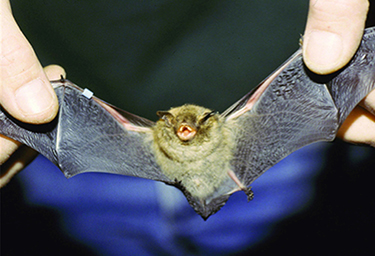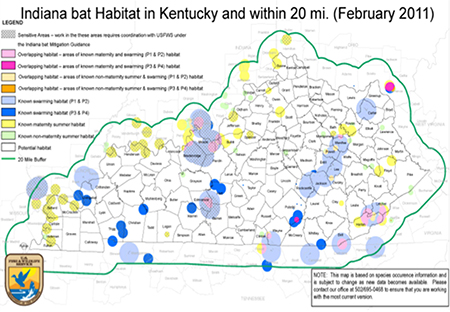|
In developing transportation projects, agencies must balance environmental impact considerations with their responsibility to deliver projects in a timely and cost-effective manner. The Indiana bat (Myotis soldalis) is an endangered species whose summer roosting and hibernation sites are found throughout Kentucky. Because of the bats' widespread territory, almost all State transportation projects, which are developed and implemented by the Kentucky Transportation Cabinet (KYTC), may potentially impact the species or its habitat. The U.S. Fish and Wildlife Service (USFWS) works with KYTC to ensure that impacts on Indiana bats or their habitat are compliant with the Endangered Species Act (ESA). In the past, KYTC consulted with the USFWS on a project-by-project basis. To comply with the ESA, KYTC conducted frequent and repetitive survey and assessment activities for the Indiana bat, which required substantial administrative effort even if the avoidance and minimization outcomes were predictable and routine. This process resulted in project delays and increased ESA compliance costs.
To streamline the environmental review process, KYTC and the Federal Highway Administration's (FHWA) Kentucky Division Office worked with the USFWS to develop a standard approach for biological surveys and assessments that would reduce the time and expense of consultations, provide more options for compliance with the ESA, and also contribute to the USFWS's statewide conservation and recovery goals for the Indiana bat. A Programmatic Biological Assessment (PBA) as well as a Programmatic Conservation Memorandum of Agreement (MOA) now guide a more efficient environmental review process for the Indiana bat throughout Kentucky and focus valuable resources toward the species' conservation.

The Indiana bat (Myotis soldalis) is protected under the ESA.
(Courtesy of KYTC)
Threats to the Indiana Bat
The Indiana bat hibernates in large cave colonies in winter, migrates to forested roosting habitat in the spring and summer, and returns to feed and mate in forested areas outside the hibernation sites in the fall. Indiana bats feed on insects in forested areas and roost under the exfoliating or loose bark of live trees. Current rates of habitat loss, migration patterns, low birth rates, and the low number of suitable hibernation sites make Indiana bats particularly vulnerable to further habitat fragmentation and disturbance.
The Indiana bat has been listed as endangered since 1973, when its population was estimated at 880,000. In 2011, the Indiana bat's population was estimated at 424,000, with approximately 70,000 (14 percent) occurring in Kentucky. Because transportation projects such as road widenings and realignments may require the removal of trees, disrupt cave entrances, or alter bridges or old mines where bats may roost and hibernate, both KYTC and the FHWA Kentucky Division Office have significant roles to play in the species' conservation and recovery.
More Efficient and Effective Environmental Reviews
Before the development of the PBA and Programmatic Conservation MOA in 2012, project assessments for the Indiana bat would take KYTC approximately 30 to 60 days. Regardless of size or type, all Federal-aid projects required a description of the potential impact on the Indiana bat. KYTC carried out more than 100 Indiana bat biological assessments a year, with most of the time spent conducting presence and absence surveys to identify bat occurrences and habitat locations. Not only was this process costly, but it delayed critical project development decisionmaking. Furthermore, project-level mitigation responses were focused on addressing localized impacts rather than more comprehensive protection and recovery strategies.

This map depicts known and potential Indiana bat habitat in Kentucky and within 20 miles of the State border. (Courtesy of KYTC)
Prior Interagency Collaboration
In 2006, KYTC developed a PBA that proposed replacing the project-by-project consultation process with a two-tiered, standardized approach to presence and absence surveys and mitigation. Working closely with the USFWS, KYTC developed an accompanying Habitat Assessment Manual that defined a process for determining the presence or absence of Indiana bat habitat and streamlined the consultation process by identifying the types of projects and environmental circumstances that could be appropriately determined as having “no effect” on the species. USFWS issued a biological opinion, which remained in effect until 2011, to address any adverse effects associated with the process. During that time, surveys for Indiana bats were reduced to approximately 20 per year.
The 2006 biological opinion also established an Indiana Bat Conservation Fund (IBCF). KYTC could opt to make payments to the fund to offset likely impacts instead of performing full biological assessments for the presence of bats. IBCF funding was then directed toward statewide efforts that make a more cumulative impact on the protection of Indiana bats than may be possible through isolated, project-based mitigation efforts.
In 2008, the USFWS issued an intra-service biological opinion and Indiana bat mitigation guidance for Kentucky. The opinion and guidance expanded the IBCF by making the mitigation mechanism available to any Kentucky agency or entity through the use of voluntary project-specific Conservation MOAs, and established a statewide limit of incidental “takes” (harm or disruption of the bat or its habitat) that participating entities may utilize. In early 2011, the USFWS revised the Indiana bat mitigation guidance and modified the intra-service biological opinion to reduce the statewide incidental take limit to 2,500 acres of forested Indiana bat habitat per year through 2016. These documents laid the groundwork for the revised 2012 PBA and Programmatic Conservation MOA developed with the USFWS, KYTC, and FHWA by providing standard definitions of terms, identifying priority habitats and take limits, and noting the acceptability of various mitigation efforts.
A Streamlined Approach to the Protection of the Indiana Bat
The 2012 PBA and Programmatic Conservation MOA, which will remain in effect until 2016, continue the two-tiered approach from the 2006 PBA. Tier 1 of the 2012 PBA outlines a standardized analysis for the determination of whether the Indiana bats' summer or winter habitat is potentially present and would be impacted by a project. This approach reduces the need to conduct a biological survey for every project, allowing KYTC to develop a determination of “no effect” without further consultation with the USFWS.
If a habitat is found to be potentially present, Tier 2 of the 2012 PBA provides a number of ESA compliance options based on the type of transportation project, whether the project lies within a known or potential habitat area, and whether the project impacts a winter or summer habitat. Projects that may impact critical winter habitats (such as caves and old mines), or more than 250 acres of summer habitats, are not covered by this PBA; consultation with the USFWS is required in these instances. For smaller projects, such as tree trimming activities within 100 feet of pavement, Tier 2 provides the blanket determination of “not likely to adversely affect” the Indiana bat and no further consultation is required. For projects that receive a “may affect, likely to adversely affect” determination during Tier 1, the KYTC project manager may utilize any of the ESA compliance options available for Tier 2. These options include further biological assessments or surveys, seasonal tree cutting restrictions, formal consultation with the USFWS, or a payment to the IBCF.
Benefits of the Indiana Bat Programmatic Agreement
The Indiana bat PBA and the Programmatic Conservation MOA allow for expedited environmental review processes that enable KYTC project managers to plan for avoidance or mitigation activities. For instance, depending on the season, project managers may choose to contribute to the IBCF instead of conducting a costly survey or waiting for summer tree cutting restrictions to expire, as these options may complicate construction letting schedules. The flexibility provided by the agreement decreases redundant costs for surveying and staff time in developing project-specific MOAs, resulting in a more predictable project delivery process.
To date, funding in the IBCF has contributed to the purchase of protected Indiana bat habitat throughout Kentucky, as well as to the installation of gates to restrict human access at critical hibernation sites. Due to the up-front work provided by the 2011 biological opinion, the USFWS also reduced the amount of negotiation necessary to develop the Programmatic Conservation MOA by providing standard definitions of Indiana bat habitat types and mitigation responses and articulating a statewide conservation and recovery approach that various agencies can apply to their own processes. This ensures that ESA compliance activities by KYTC and other agencies are in line with and meaningful to statewide Indiana bat conservation and recovery efforts.
Contact Information
David Waldner
Division of Environmental Analysis
Kentucky Transportation Cabinet
(502) 564-7250
David.Waldner@ky.gov
Anthony Goodman
Kentucky Division Office
Federal Highway Administration
(502) 223-6742
Anthony.Goodman@dot.gov
Look What's New!
- The Transportation Research Board (TRB) 92nd Annual Meeting will be held January 13 through 17, 2013, in Washington, D.C. The Annual Meeting attracts more than 11,000 transportation professionals and covers an array of transportation modal, policy, and technology topics. For more information and to register, visit the TRB website.
- At the request of FHWA, the Advisory Council on Historic Preservation has issued a final Program Comment that outlines a process aimed at streamlining historic review requirements for more than 196,000 of the nation's most common bridges. With some limited exceptions, it would relieve Federal agencies from the need to individually consider the effects of undertakings on most standard reinforced concrete and steel bridges that otherwise would be subject to Section 106 review.
- FHWA developed the Transportation Liaison Community of Practice (CoP) to enrich the streamlining and coordination services that transportation liaisons provide by enabling the sharing of best practices and exchange of knowledge and resources. The CoP includes a resource library where users can read and share examples of programmatic agreements, as well as a discussion board to engage with colleagues in the field. Liaisons, liaison managers, and staff at State DOTs, resource and regulatory agencies, and FHWA Division Offices are invited to register for the CoP and discussion board using their government email address.
|

